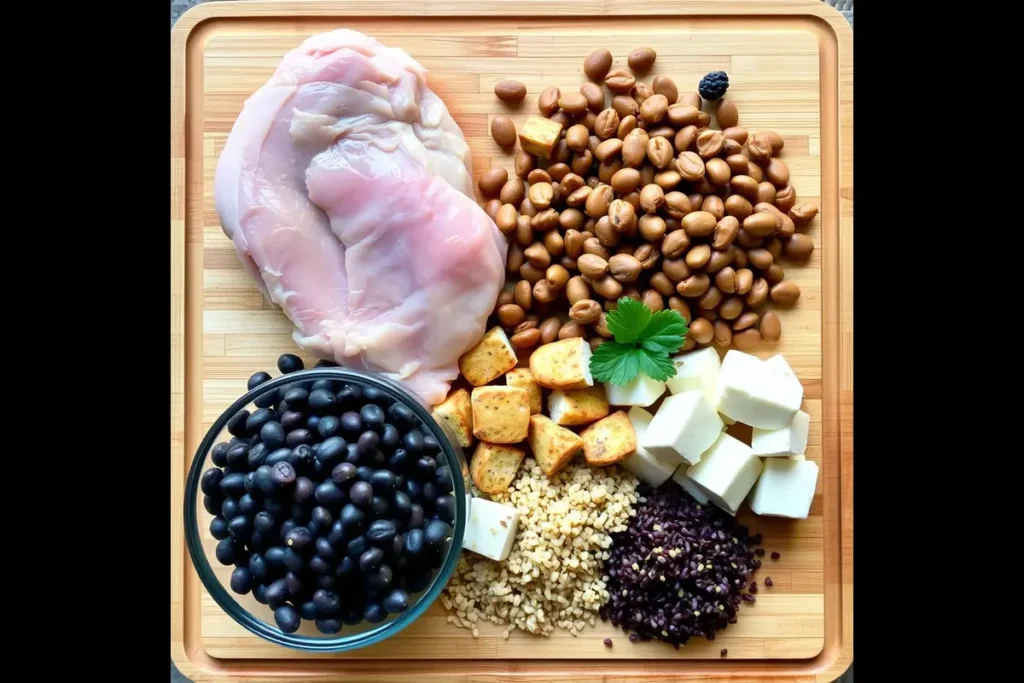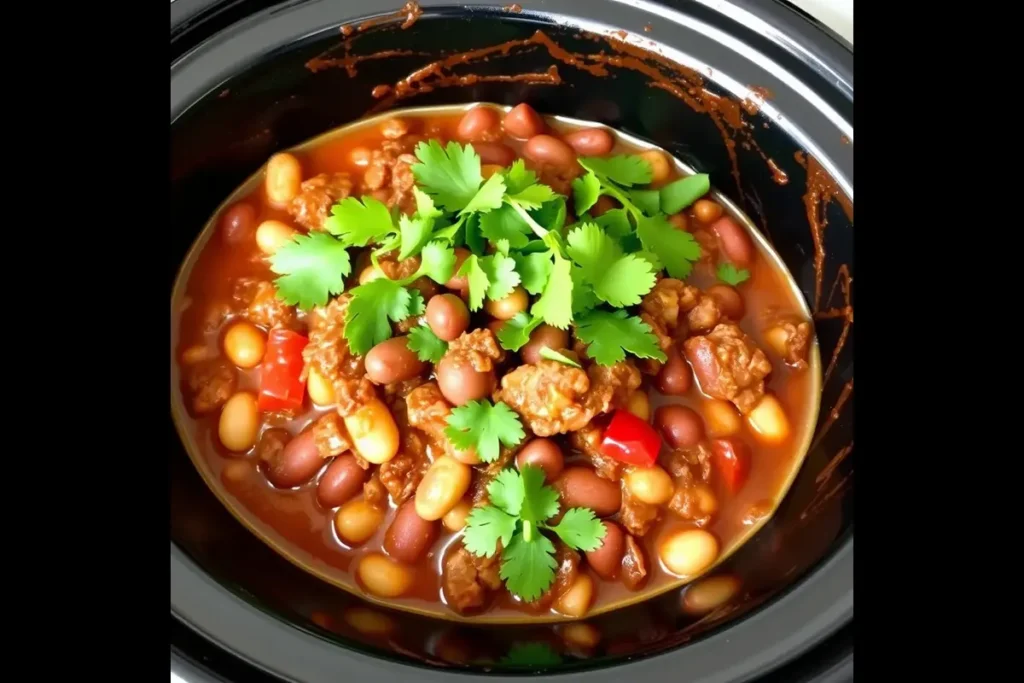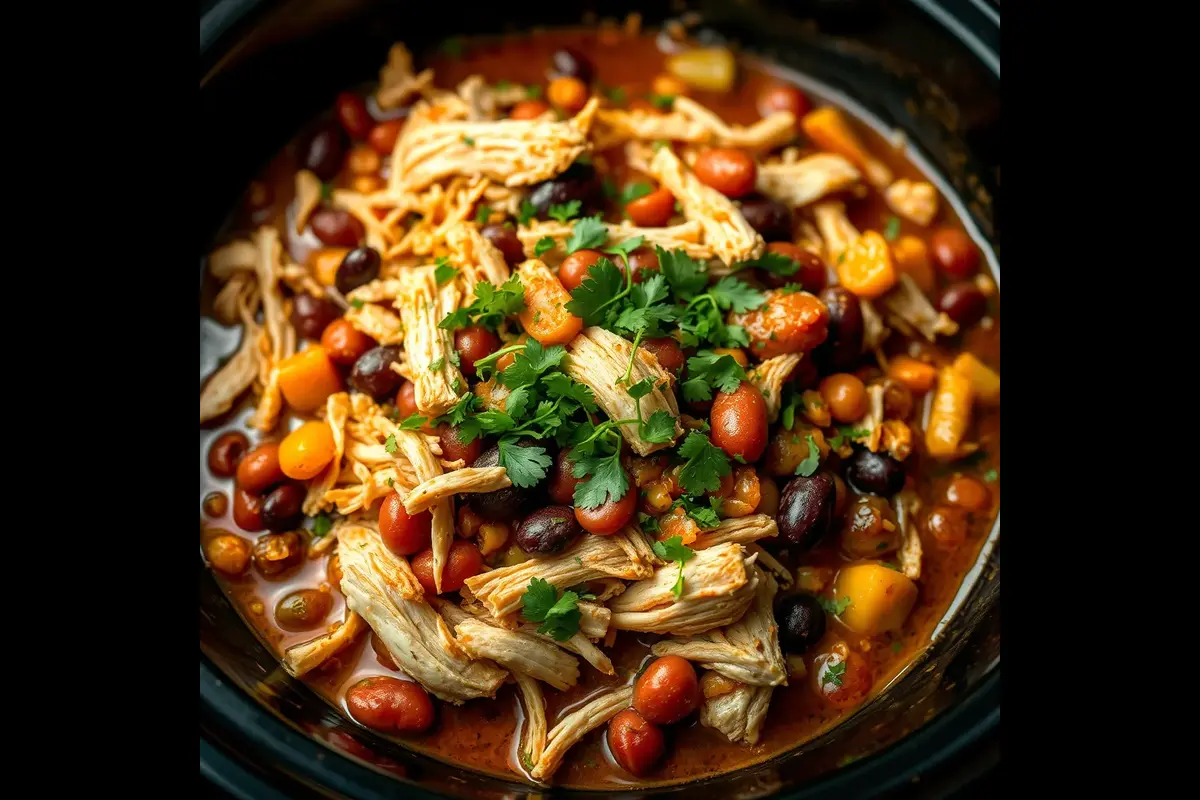High-protein slow cookers are undeniably a game-changer for anyone looking to prepare nutritious, high-protein meals without stress. Not only do they simplify the cooking process, but they also enhance flavors through the magic of slow cooking. As a result, they become an ideal solution for those with busy lifestyles, offering convenience and delicious results.
In this guide, we’ll explore the many benefits of using a high-protein slow cooker. Additionally, we’ll delve into the best protein sources to incorporate, share some of the most popular recipes, and provide expert tips to help you perfect your creations. By the end, you’ll see how easy it is to make wholesome, high-protein meals that suit your daily routine.
Benefits of Using a Slow Cooker for High-Protein Meals
Why Choose a Slow Cooker for High-Protein Recipes?
Convenience and Time-Saving
Using a high protein slow cooker is as simple as setting it and forgetting it. Whether you’re tackling a busy workday or managing household tasks, slow cookers allow you to prepare meals with minimal supervision. Just toss in your protein-rich ingredients, set the timer, and come back to a perfectly cooked dish.
Retaining Nutritional Value
Slow cooking preserves nutrients that can be lost in high-heat cooking methods. Proteins like chicken and lentils retain their integrity while absorbing the rich flavors of accompanying spices and herbs. This method ensures that your high-protein meals are not only delicious but also packed with essential nutrients.
Budget-Friendly Meal Prep
Slow cookers shine when it comes to making budget-friendly meals. Economical protein sources, like beans and lentils, become soft and flavorful after hours of slow cooking. Plus, you can use affordable cuts of meat, like chicken thighs or pork loin, which tenderize beautifully in the slow cooker.
Ideal for Batch Cooking
Preparing large portions in a slow cooker means you can cook once and eat multiple times. High-protein dishes like chili or stews freeze well, making meal prep a breeze and ensuring you always have a nutritious option on hand.

Part 3: Top Protein Sources for Slow Cooker Recipes
Choosing the Best Proteins for Your Slow Cooker
Meat Options
Meat is a cornerstone of many high-protein slow cooker recipes. These options are not only versatile but also cook beautifully over low heat, resulting in tender, flavorful meals.
- Chicken Breast: Lean and packed with protein, chicken breast is a favorite for slow-cooked soups and stews. Its mild flavor allows it to absorb spices and marinades effectively.
- Turkey: Ground turkey or turkey breast are excellent low-fat protein choices. They work wonderfully in meatball dishes or turkey chili.
- Lean Beef: Cuts like sirloin or round roast provide robust flavor and high protein content. Slow cooking tenderizes these cuts, making them perfect for dishes like beef stew or shredded beef tacos.
- Pork Loin: This lean cut of pork benefits from the slow cooker’s moist heat, resulting in juicy, protein-rich pulled pork or pork roast recipes.
Plant-Based Proteins
For vegetarians or those looking to reduce meat consumption, plant-based proteins are a fantastic alternative.
- Lentils: High in protein and fiber, lentils cook quickly and absorb flavors, making them a staple for hearty curries and stews.
- Black Beans and Chickpeas: These legumes are protein powerhouses. Use them in soups, chili, or as a base for a protein-packed vegan stew.
- Tofu and Tempeh: Both tofu and tempeh work well in slow cooker dishes, soaking up marinades and spices while maintaining their texture.
- Edamame: These young soybeans add a touch of protein and freshness to slow-cooked casseroles or stir-fries.
Seafood Options
While seafood is more delicate than other proteins, it can still shine in slow cooker recipes when added toward the end of cooking.
- Salmon: Rich in omega-3 fatty acids, salmon adds a healthy dose of protein and a buttery flavor to slow-cooked chowders or casseroles.
- Cod: Its firm texture makes cod a great choice for stews and soups.
- Shrimp and Scallops: Quick-cooking seafood like shrimp and scallops should be added in the final 15–20 minutes to prevent overcooking.
Protein-Rich Add-Ins
Boost your slow cooker recipes with protein-packed additions that complement the main ingredients.
- Quinoa: This high-protein grain cooks beautifully in slow cookers, adding texture and nutrients to soups and stews.
- Eggs: Include whole eggs or egg whites in slow-cooked breakfast casseroles for a protein-packed start to the day.
- Greek Yogurt: Stir it into soups or curries after cooking to add creaminess and an extra protein punch.
- Cheese: A sprinkle of Parmesan or a layer of shredded cheddar can elevate slow-cooked dishes, adding flavor and a dose of protein.

Part 4: Popular High-Protein Slow Cooker Recipes
Delicious High-Protein Recipes for Your Slow Cooker
Hearty Meat-Based Recipes
Meat-based slow cooker dishes are rich, satisfying, and packed with protein to keep you energized.
- Slow-Cooked Pulled Chicken: Marinate chicken breasts in a blend of barbecue sauce, garlic, and paprika, then slow cook until tender. Shred and serve on whole-grain buns or over salads.
- Beef Chili with Beans: Combine lean ground beef, black beans, kidney beans, tomatoes, and a mix of spices. Simmer on low for hours to create a rich, flavorful chili perfect for meal prep.
- Turkey Meatball Soup: Form ground turkey into small meatballs and slow cook them in a broth with carrots, celery, and spinach for a light yet protein-packed meal.
Plant-Based High-Protein Recipes
These vegetarian options prove that you don’t need meat to enjoy a high-protein meal.
- Lentil Curry: Combine red lentils, coconut milk, diced tomatoes, and curry spices for a creamy, flavorful dish that pairs perfectly with rice.
- Black Bean and Quinoa Stew: Slow cook black beans, quinoa, corn, and bell peppers with a dash of cumin and lime juice for a satisfying vegan stew.
- Vegan Tofu Tikka Masala: Marinate tofu cubes in a spiced yogurt substitute, then slow cook them in a tomato-based masala sauce for a high-protein Indian-inspired meal.
Seafood-Based High-Protein Recipes
Seafood dishes in a slow cooker offer light yet protein-rich meal options.
- Salmon Chowder: Combine salmon chunks, potatoes, onions, and a creamy broth in your slow cooker for a comforting and nutritious chowder.
- Shrimp and Vegetable Stir-Fry: Add shrimp and a mix of colorful vegetables in the last 20 minutes of cooking for a quick and protein-packed dinner.
Breakfast and Snack Options
Start your day or snack smartly with these high-protein slow cooker options.
- Egg Casseroles: Combine eggs, diced vegetables, and cheese in the slow cooker for a ready-to-eat breakfast that’s both filling and nutritious.
- Protein-Packed Oatmeal: Slow cook steel-cut oats with protein powder, almond butter, and chia seeds for a wholesome breakfast option.
Part 5: Tips for Making High-Protein Slow Cooker Meals
How to Perfect Your High-Protein Recipes in a Slow Cooker
Layer Ingredients Properly
Achieving even cooking in a slow cooker starts with the right layering technique.
- Proteins First: Place denser proteins like chicken breast, beef, or pork at the bottom of the slow cooker. This ensures they are closest to the heat source and cook thoroughly.
- Vegetables Next: Add firmer vegetables like carrots, potatoes, and onions on top of the protein. Their slower cooking times align perfectly with the meat’s.
- Delicate Ingredients Last: Include tender vegetables, grains, or seafood in the final hour of cooking to prevent overcooking.
Adjusting Cooking Times for Different Proteins
Cooking times vary depending on the type of protein used.
- Meats: Chicken breasts and pork loins typically require 4–6 hours on low.
- Seafood: Shrimp, scallops, and fish need only 15–30 minutes toward the end of cooking to avoid becoming rubbery.
- Legumes: Lentils and beans can handle long cooking times, making them a great base for high-protein stews.
Using Flavor Enhancers
Slow cooking is perfect for infusing dishes with robust flavors.
- Spices and Herbs: Add dried herbs like thyme or bay leaves at the beginning, and fresh herbs like parsley or cilantro just before serving for a flavor boost.
- Marinades: Marinating proteins overnight adds depth to the flavor, ensuring the slow cooking process enhances rather than dilutes the seasoning.
- Acids: Incorporate a splash of vinegar or citrus juice near the end of cooking to brighten the dish.
Ensuring Balanced Meals
High-protein meals are great, but balance is key for a wholesome diet.
- Vegetables: Mix in a variety of vegetables to add fiber, vitamins, and minerals.
- Grains: Incorporate quinoa, barley, or brown rice for a dose of complex carbohydrates.
- Healthy Fats: Drizzle olive oil or sprinkle nuts for added texture and essential fats.
Part 6: Common Mistakes and How to Avoid Them
Avoiding Pitfalls in High-Protein Slow Cooker Recipes
Overcooking Proteins
Slow cooking is forgiving, but overcooking can dry out even the juiciest cuts.
- Set the Timer: Follow recommended cooking times and use a timer to prevent overcooking.
- Monitor Delicate Proteins: Add seafood or tender cuts like salmon in the last 30 minutes to preserve their texture.
Skipping Liquid Adjustments
Liquid is essential for maintaining moisture in slow-cooked meals.
- Add Just Enough: Include enough liquid to cover the protein, but not so much that the dish becomes watery.
- Broth Over Water: Use broth instead of water to enhance the flavor of the dish.
Neglecting Ingredient Sizes
Uniform ingredient sizes ensure even cooking and an appealing presentation.
- Cut Evenly: Dice vegetables and proteins to similar sizes to avoid undercooked or overcooked pieces.
- Layer Wisely: Place smaller or more delicate ingredients on top to prevent them from being crushed.
Part 7: FAQs About High-Protein Slow Cooker Recipes
Can I use frozen proteins in the slow cooker?
Yes, frozen proteins can be used in a slow cooker, but it requires extra care.
Defrosting Tips: While it’s safe to cook frozen meats directly, it may take longer to reach the proper temperature. Defrosting in the refrigerator overnight is recommended for even cooking.
Safety Guidelines: Ensure the internal temperature of the protein reaches 165°F (74°C) for poultry and 145°F (63°C) for seafood or red meat to ensure food safety.
How do I increase protein content in vegetarian slow cooker meals?
Vegetarian meals can be just as protein-rich with the right ingredients.
Legumes: Add lentils, chickpeas, or black beans for a substantial protein boost.
Quinoa: This versatile grain is high in protein and cooks well in slow cooker soups or stews.
Tofu and Tempeh: Include these plant-based proteins to create balanced vegetarian dishes.
Chia Seeds or Nuts: Sprinkle them as toppings for additional protein and texture.
Are slow cooker meals good for muscle building?
Absolutely! Slow cooker meals are perfect for fitness enthusiasts aiming to build muscle.
High-Protein Options: Dishes like pulled chicken, turkey chili, and lentil curry provide a robust protein base.
Meal Prep-Friendly: Slow-cooked meals are easy to portion and store, making them ideal for consistent protein intake.
Customizable Recipes: Add eggs, Greek yogurt, or protein powder to enhance protein content for muscle recovery and growth.
How long can high-protein meals be stored?
Proper storage extends the shelf life of slow cooker meals.
Refrigeration: Store in airtight containers in the fridge for 3–4 days.
Freezing: Freeze portions for up to 3 months, ensuring they’re well-wrapped or stored in freezer-safe containers.
Reheating Tips: Reheat thoroughly, ensuring the dish reaches a safe internal temperature of 165°F (74°C) before consuming.
Part 8: Simplify Healthy Eating with High-Protein Slow Cooker Recipes
Recap the Benefits of Using a Slow Cooker for High-Protein Meals
Slow cookers offer a hassle-free way to prepare nutritious, high-protein meals. Whether you’re cooking tender meats, plant-based dishes, or protein-packed soups, this method ensures flavorful results with minimal effort.
Encouragement to Experiment with Recipes and Enjoy the Convenience
Don’t shy away from experimenting with new ingredients and flavors. A slow cooker allows you to enjoy diverse, nutrient-rich meals while saving time and effort.
From meal prep to muscle-building diets, high-protein slow cooker recipes fit seamlessly into any lifestyle. Dive in and enjoy the convenience of healthy, hearty cooking!

